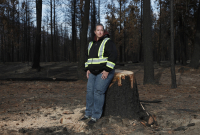Support strong Canadian climate journalism for 2025
With the annual United Nations climate conference just around the corner, environmental groups are calling for an end to subsidies that support burning forest biomass to generate electricity.
In an open letter to Natural Resources and Energy Minister Jonathan Wilkinson and Environment Minister Steven Guilbeault, the groups say financial support for the industry is at odds with the federal government's pledge to phase out subsidies that harm biodiversity. The 27 signatories urge the government to “reverse course and choose true climate solutions” instead of “simply shifting from burning fossil fuels to burning forests for fuel.”
Wilkinson did not respond to a request for comment by deadline.
Forest biomass includes all parts of the tree: bark, branches, needles, leaves and roots. These leftovers from trees being processed into lumber can be turned into wood pellets and burned to create electricity.
The wood pellet industry has been under scrutiny for years. Research published by the Canadian Centre for Policy Alternatives (CCPA) in 2021 found 12 per cent of logged material in B.C. is eventually broken down for biofuel. Then, last October, a BBC investigation revealed the Drax Group, a U.K.-based renewable energy company, sources some of its biomass from whole trees in B.C.’s primary forests — not just sawdust and waste wood, as the company claims.
Drax operates the world’s largest wood-fired thermal electricity plant in Yorkshire, U.K., and has a growing monopoly on Canada’s wood pellet industry. Several groups, including Unifor, want Canada’s Competition Bureau to investigate Drax’s dominant position in B.C., which they say could have negative consequences for both forest ecosystems and forest industry employment in the province.
Seven months after BBC’s investigation broke, the U.K.’s energy regulator launched a formal investigation into Drax to determine whether the company is violating sustainability rules.
Natural Resources Canada says forest biomass is a “renewable source of feedstock for energy production” as long as it comes from a sustainably managed forest and regrows over time. The department webpage outlines some of the complex considerations around forest bioenergy production, like how much biomass can be removed from a site without causing negative environmental impacts. The wood pellet industry bills it as a clean alternative to coal, and the European Union counts wood and other biomass as carbon neutral.
However, scientific research and life cycle analyses paint a very different picture. Research on forest biomass by the European Academies Science Advisory Council in 2019 found removing and burning forest carbon stocks leads to an initial increase in emissions and the time it takes for forests to regrow and reabsorb the emissions is “incompatible with the urgency of reducing emissions” to meet global climate goals.
A 2018 life cycle analysis published in Environmental Research Letters compared the use of coal and wood for power generation and found even in the short term, burning wood leads to more CO2 in the atmosphere.
“Assuming biofuels are carbon neutral may worsen irreversible impacts of climate change before benefits accrue,” reads the abstract of the study.
The open letter urges the ministers to “reject biomass as a source of renewable energy — both at home with real renewables readily available and abroad — at COP28.”
COP28 refers to the 2023 United Nations Climate Change Conference, set to begin on Nov. 30 in Dubai. World leaders gather at these conferences to assess global efforts to address climate change and chart a path forward through sometimes fraught negotiations.
The 27 signatories to the open letter include Stand.earth, the David Suzuki Foundation, Nature Canada, the Wildlands League and the Natural Resources Defense Council, to name a few.
The groups want the federal government to work with other levels of government to ensure forests are off-limits to wood pellet production for export and end all subsidies for the utility-scale wood pellet industry. Instead, the letter urges the funds to be redirected to Indigenous land use, stewardship, restoration projects “and real climate solutions such as wind and solar power.” It also calls on the government to “advocate on the international stage” to close carbon accounting “loopholes” that present utility-scale exported biomass as carbon neutral.
The $1.5-billion Clean Fuels Fund has a funding stream specifically for projects that support the establishment of biomass supply chains, including forest biomass feedstocks. The call for proposals closed last November and no funding agreements have been announced yet. Biomass for heat or energy and pellet manufacturing are among the eligible projects for the federal government’s Indigenous Forestry Initiative and Investment in Forest Industry Transformation programs. Several other programs aren’t specifically aimed at bioenergy, but projects could be eligible if they meet all the program criteria.
In 2021, the CCPA looked at subsidies in B.C. and estimated at least $37 million in taxpayer dollars went directly to wood pellet mills, pulp mills or companies bringing lower-quality logs into mill towns.
Stand.earth’s 2021-22 research showed, British Columbia has 13 exporting pellet mills, the most of all the provinces. The province’s 13 mills account for 58 per cent of Canada’s industrial export capacity. Quebec’s three mills account for 15 per cent of export capacity; Alberta has two mills accounting for 17 per cent of export capacity. New Brunswick has three mills, Nova Scotia has two and Ontario has one.
Nearly 85 per cent of Canada’s pellet production, or approximately 1.3 million tonnes, is exported, according to Natural Resources Canada. Canada is currently the world’s third-largest exporter of wood pellets, the majority of which goes to the U.K. and Japan, but South Korea’s imports are rising quickly, according to a United States International Trade Commission briefing from June.
“In their efforts to transition away from coal, power utilities overseas are simply replacing one polluting fuel with another and benefiting from public funds meant to support renewable energy industries that are proven to curb carbon emissions,” said Richard Robertson, a forest campaigner at Stand.earth.
“Australia has taken a stand,” Robertson added in a phone interview with Canada’s National Observer.
In December 2021, Australia’s federal government announced electricity generated from burning native forest wood waste is not eligible under the country’s Renewable Energy Target.
Natasha Bulowski / Local Journalism Initiative / Canada’s National Observer
A previous version of the letter only had 24 signatories listed, but there are 27. The article has been updated to reflect this.






Comments
To paraphrase the European Academies’ Science Advisory Council, forest biomass for energy can be climate neutral or climate positive after a short "payback period" only in very specific circumstances, such as when where wastes or thinnings from forestry operations would have been left on site. Cutting trees for bioenergy is highly destructive.